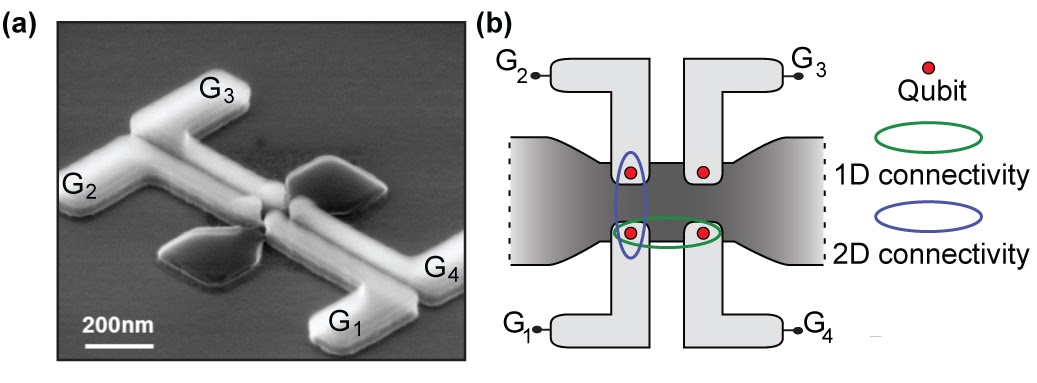Researchers at the Niels Bohr Institute are working to overcome obstacles in developing a working quantum computer as part of a pan-European collaboration with French microelectronics developer CEA-Leti. The collaboration aims to explore the use of transistors as qubits and has demonstrated the development of two-dimensional array which helps to improve error correction in this new device.
One of the obstacles for progress in the quest for a working quantum computer has been the development of Qubits. Previously these have only been produced by universities and in small numbers. However, researchers at the Niels Bohr Institute, University of Copenhagen, found that they could use CEA-Leti wafers. These industrially produced devices were found to be suitable as a platform for a two-dimensional array of qubits, a significant step for a working quantum computer. The results of this study have now been published in Nature Communications.
One of the key features of the devices is the two-dimensional array of quantum dots. Or more precisely, a two by two lattice of quantum dots. Dr Fabio Ansaloni, a postdoc at the Center for Quantum Devices at NBI said: ‘What we have shown is that we can realise single electron control in every single one of these quantum dots. This is very important for the development of a qubit, because one of the possible ways of making qubits is to use the spin of a single electron. So reaching this goal of controlling the single electrons and doing it in a 2D array of quantum dots was very important for us.’
The paper published in Nature Communications, authored by Ansaloni and his colleagues states: ‘We demonstrate single-electron occupations in all four quantum dots of a 2x2 split-gate silicon device fabricated entirely by 300-mm-wafer foundry processes. By applying gate-voltage pulses while performing high-frequency reflectometry off one gate electrode, we perform single-electron operations within the array that demonstrate single-shot detection of electron tunnelling and an overall adjustability of tunnelling times by a global top gate electrode. Lastly, we use the two-dimensional aspect of the quantum dot array to exchange two electrons by spatial permutation, which may find applications in permutation-based quantum algorithms.’
Using electron spins has proven to be advantageous for the implementation of qubits. In fact, their ‘quiet’ nature makes spins weakly interacting with the noisy environment, an important requirement to obtain highly performing qubits. Extending quantum computers processors to the second dimension has been proven to be essential for a more efficient implementation of quantum error correction routines. Quantum error correction will enable future quantum computers to be fault-tolerant against individual qubit failures during the computations.

Caption: a) Scanning electron image of one of the Foundry-fabricated quantum dot devices. Four quantum dots can be formed in the silicon (dark grey), using four independent control wires (light grey). These wires are the control knobs that enable the so-called quantum gates. (b) Schematic of the two-dimensional array device. Each Qubit (red circle) can interact with its nearest neighbour in the two-dimensional network, and circumvent a Qubit that fails for one reason or other. This setup is what “second dimension” means.
The importance of industry-scale production
Assistant Professor at Center for Quantum Devices, NBI, Anasua Chatterjee adds: ‘The original idea was to make an array of spin qubits, get down to single electrons and become able to control them and move them around. In that sense, it is really great that Leti was able to deliver the samples we have used, which in turn made it possible for us to attain this result. A lot of credit goes to the pan-European project consortium, and generous funding from the EU, helping us to slowly move from the level of a single quantum dot with a single electron to having two electrons, and now moving on to the two-dimensional arrays. Two-dimensional arrays are a really big goal, because that’s beginning to look like something you absolutely need to build a quantum computer. So Leti has been involved with a series of projects over the years, which have all contributed to this result.’
The development has been gradual. In 2015, researchers in Grenoble succeeded in making the first spin qubit, but this was based on holes, not electrons. Back then, the performance of the devices was not optimal, and the technology has advanced so that the devices now at NBI can have two-dimensional arrays in the single electron regime.
The progress is threefold, the researchers explain: ‘First, producing the devices in an industrial foundry is a necessity. The scalability of a modern, industrial process is essential as we start to make bigger arrays, for example for small quantum simulators. Second, when making a quantum computer, you need an array in two dimensions, and you need a way of connecting the external world to each qubit. If you have 4-5 connections for each qubit, you quickly end up with an unrealistic number of wires going out of the low-temperature setup. But what we have managed to show is that we can have one gate per electron, and you can read and control with the same gate. And lastly, using these tools we were able to move and swap single electrons in a controlled way around the array, a challenge in itself.’
Two-dimensional arrays can reduce errors
The computers we use today produce plenty of errors, but they are corrected through what is called the repetition code. In a conventional computer, you can have information in either a 0 or a 1. In order to be sure that the outcome of a calculation is correct, the computer repeats the calculation and if one transistor makes an error, it is corrected through a simple majority.
If the majority of the calculations performed in other transistors point to 1 and not 0, then 1 is chosen as the result. This is not possible in a quantum computer since you cannot make an exact copy of a qubit, so quantum error correction works in another way: State-of-the-art physical qubits do not have low error rate yet, but if enough of them are combined in the 2D array, they can keep each other in check, so to speak. This is another advantage of the now realised 2D array.
The result realised at the Niels Bohr Institute shows that it is now possible to control single electrons, and perform the experiment in the absence of a magnetic field. So the next step will be to look for spins – spin signatures – in the presence of a magnetic field. This will be essential to implementing single and two-qubit gates between the single qubits in the array. The theory has shown that a handful of single and two-qubit gates, called a complete set of quantum gates, are enough to enable universal quantum computation.
The paper also notes the importance of this research for the development of fault-tolerant quantum computers. ‘The development of 2 × N qubit arrays may prove useful for the realisation of fault-tolerant spin-qubit quantum computers, trading topological constraints against lower error thresholds. The systematic loading of such extended arrays with individual electrons, as well as the controlled movement of electrons along the array, can be facilitated by virtual control channels similar to those used in linear arrays. Recent experiments even suggest that the capacitive coupling of multiple 2×N arrays on one chip may be possible, opening further opportunities for functionalisation and extensions.


